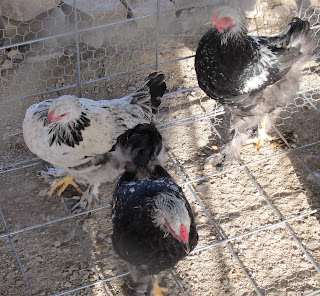Got home yesterday to find all our animals healthy and happy! Nacho and Corazon are just as rambunctious as ever, and a little bit bigger, too. We owe a huge debt to Dan & Jess, and Regina, who took care of the critters while we were gone!
The chickens' new waterer worked perfectly, and they only used half of the 100 gallon reservoir in the three weeks we were gone. That's just 0.15 gallons of water per bird, per day. And there is no algae growing in the tank, the lines, or the bucket. The new waterer is a huge success!
We also decided to separate the extra male chickens from the girls, to give everyone a little more room and a little less stress. The chicken tractor has 64 square feet of free space now that all the meat birds are in the freezer. When the birds become sexually mature, we'll build breeding pens and hopefully have some hen-raised chicks.
 |
| The boys' club. |
The Dark Brahma cockerels are easy to distinguish because they are almost entirely black, whereas the hens are penciled brown/black. The Light Brahma cockerels are harder to distinguish, but now that they are almost 15 weeks old, the saddle feathers have come in. The saddle feathers on a male Brahma are longer and narrower than on a female. Other than that, they look identical at this age.
 |
| A Dark Brahma hen |
My little Light Brahma cockerel is full of piss and vinegar, which makes sense because he is smaller than the other males but still maintains dominance over them. It is also annoying, because he is the only bird I've ever had that bit me. He better make some beautiful babies, or he will end up in freezer camp.
 |
| See the long and narrow saddle feathers? The top cock is the only one to keep his sickle feathers. |





Glad to see that y'all made it back safe and sound. Marilynn and I were down in mid-September and missed seeing y'all. Hopefully our next trip down we can meet up again.
ReplyDelete-Brad